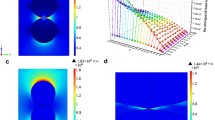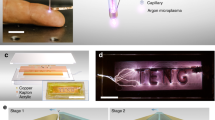Abstract
Diverse interactions between microwaves and irradiated media provide a solid foundation for identifying novel organization pathways for energy flow. In this study, a high-energy-site phenomenon and targeted-energy transition mechanism were identified in a particular microwave heating (MH) process. Intense discharges were observed when microwaves were imposed on irregularly sized SiC particles, producing tremendous heat that was 8-fold the amount generated in the discharge-free case. Energy efficiency was thereby greatly improved in the electricity-microwaves-effective heat transition. Meanwhile, the dispersed microwave field energy concentrated in small sites, where local temperatures could reach 2000°C–4000°C, with the energy density reaching up to 4.0 × 105 W/kg. This can be called a high-energy site phenomenon which could induce further processes or reactions enhancement by coupling effects of heat, light, and plasma. The whole process, including microwave energy concentration and intense site-energy release, shapes a targeted-energy transition mechanism that can be optimized in a controlled manner through morphology design. In particular, the discharge intensity, frequency, and high-energy sites were strengthened through the fabrication of sharp nano/microstructures, conferring twice the energy efficiency of untreated metal wires. The microwave-induced high-energy sites and targeted energy transition provide an important pathway for high-efficiency energy deployment and may lead to promising applications.
Similar content being viewed by others
References
Sun J, Wang W, Yue Q. Review on microwave-matter interaction fundamentals and efficient microwave-associated heating strategies. Materials (Basel), 2016, 9(4): 231
Horikoshi S, Watanabe T, Narita A, et al. The electromagnetic wave energy effect(s) in microwave-assisted organic syntheses (MAOS). Scientific Reports, 2018, 8(1): 5151
Sun J, Jiang Z, Wang K, et al. Experimental study on microwave-SiC-assisted catalytic hydrogenation of phenol. Energy & Fuels, 2019, 33(11): 11092–11100
Li J, Tao J, Yan B, et al. Microwave reforming with char-supported Nickel-Cerium catalysts: a potential approach for thorough conversion of biomass tar model compound. Applied Energy, 2020, 261: 114375
Ellison C R, Hoff R, Mărculescu C, et al. Investigation of microwave-assisted pyrolysis of biomass with char in a rectangular waveguide applicator with built-in phase-shifting. Applied Energy, 2020, 259:114217
Chen Y. Microwave pyrolysis of oily sludge with activated carbon. Environmental Technology, 2016, 37(24): 3139–3145
Garcia-Costa A L, Zazo J A, Rodriguez J J, et al. Intensification of catalytic wet peroxide oxidation with microwave radiation: activity and stability of carbon materials. Separation and Purification Technology, 2019, 209: 301–306
Qian H, Zhu G, Xu H, et al. Preparation of tetragonal Barium titanate nanopowders by microwave solid-state synthesis. Applied Physics A, Materials Science & Processing, 2020, 126(4): 294
Hrycak B. Hydrogen production by dry reforming of kerosene using microwave plasma. Przegląd Elektrotechniczny, 2016, 1(8): 42–45
Chun S M, Shin D H, Ma S H, et al. CO2 microwave plasma—catalytic reactor for efficient reforming of methane to syngas. Catalysts, 2019, 9(3): 292
Uhm H S, Choi C H, Lee J Y, et al. Production of hydrogen-rich syngas from dimethyl ether by using a microwave steam plasma. Journal of the Korean Physical Society, 2019, 75(6): 460–465
Sergeichev K F, Lukina N A, Arutyunyan N R. Atmospheric-pressure microwave plasma torch for CVD technology of diamond synthesis. Plasma Physics Reports, 2019, 45(6): 551–560
Bogdanov S A, Gorbachev A M, Radishev D B, et al. Contraction of microwave discharge in the reactor for chemical vapor deposition of diamond. Technical Physics Letters, 2019, 45(2): 89–92
Wang S, Wang J, Ma Z, et al. Growth of aligned carbon nanotubes through microwave plasma chemical vapor deposition. Plasma Science & Technology, 2005, 7(1): 2681–2683 (in Chinese)
Fujita T, Hayashi Y, Tokunaga T, et al. Encapsulation of segmented Pd-Co nanocomposites into vertically aligned carbon nanotubes by plasma-hydrogen-induced demixing. Applied Physics Letters, 2007, 90(13): 133116
Liu Z, Zhang W, Tao J, et al. A microwave-induced room-temperature atmospheric-pressure plasma jet. IEEE Transactions on Plasma Science, 2019, 47(4): 1749–1753
Lee M U, Lee J K, Yun G S. Generation of energetic electrons in pulsed microwave plasmas. Plasma Processes and Polymers, 2018, 15(1): 1700124
Barnes B K, Ouro-Koura H, Derickson J, et al. Plasma generation by household microwave oven for surface modification and other emerging applications. American Journal of Physics, 2021, 89(4): 372–382
Polaki S R, Kumar N, Krishna N G, et al. Microwave plasma induced surface modification of diamond-like carbon films. Surface Topography: Metrology and Properties, 2017, 5(4): 045005
D’Isa F A, Carbone E D, Hecimovic A, et al. Performance analysis of a 2.45 GHz microwave plasma torch for CO2 decomposition in gas swirl configuration. Plasma Sources Science & Technology, 2020, 29(10): 105009
Chen W, Gutmann B, Kappe C O. Characterization of microwave-induced electric discharge phenomena in metal-solvent mixtures. ChemistryOpen, 2012, 1(1): 39–48
Zhou Y, Wang W, Sun J, et al. Direct caloirmetry study of metal discharge heating effects induced by microwave irradiation. Applied Thermal Engineering, 2017, 125: 386–393
Sun J, Wang Q, Wang W, et al. Exploiting the photocatalytic effect of microwave-metal discharges for the destruction of a tar model compound. Energy & Fuels, 2018, 32(1): 241–245
Sun J, Wang Q, Wang W, et al. Study on the synergism of steam reforming and photocatalysis for the degradation of Toluene as a tar model compound under microwave-metal discharges. Energy, 2018, 155: 815–823
Wang W, Liu Z, Sun J, et al. Experimental study on the heating effects of microwave discharge caused by metals. AIChE Journal, 2012, 58(12): 3852–3857
Sun J, Wang W, Liu Z, et al. Kinetic study of the pyrolysis of waste printed circuit boards subject to conventional and microwave heating. Energies, 2012, 5(9): 3295–3306
Sun J, Wang W, Liu Z, et al. Recycling of waste printed circuit boards by microwave-induced pyrolysis and featured mechanical processing. Industrial & Engineering Chemistry Research, 2011, 50 (20): 11763–11769
Sun J, Wang W, Yue Q, et al. Review on microwave-metal discharges and their applications in energy and industrial processes. Applied Energy, 2016, 175: 141–157
Lee S W, Lee S S, Yang E H. A study on field emission characteristics of planar graphene layers obtained from a highly oriented pyrolyzed graphite block. Nanoscale Research Letters, 2009, 4(10): 1218–1221
Xiao Z, She J, Deng S, et al. Field electron emission characteristics and physical mechanism of individual single-layer graphene. ACS Nano, 2010, 4(11): 6332–6336
Wu Z, Pei S, Ren W, et al. Field emission of single-layer graphene films prepared by electrophoretic deposition. Advanced Materials, 2009, 21(17): 1756–1760
Agrawal Y, Kedawat G, Kumar P, et al. High-performance stable field emission with ultralow turn on voltage from rGO conformal coated TiO2 nanotubes 3D arrays. Scientific Reports, 2015, 5(1): 11612
Zhang K, Wu S, Yang X, et al. Enhanced field emission properties of aligned sharp graphene emitter arrays prepared by freeze-drying and hydrothermal reduction. Materials Research Express, 2019, 6(7): 075608
Gupta B K, Haranath D, Chawla S, et al. Self-catalytic synthesis, structure and properties of ultra-fine luminescent ZnO nanostructures for field emission applications. Nanotechnology, 2010, 21(22): 225709
Feng J, Pang Y, Qin Z, et al. Why condensate drops can spontaneously move away on some superhydrophobic surfaces but not on others. ACS Applied Materials & Interfaces, 2012, 4(12): 6618–6625
Wang S, Feng L, Jiang L. One-step solution-immersion process for the fabrication of stable bionic superhydrophobic surfaces. Advanced Materials, 2006, 18(6): 767–770
Sun J, Wang Y, Wang W, et al. Application of featured microwave-metal discharge for the fabrication of well-graphitized carbon-encapsulated Fe nanoparticles for enhancing microwave absorption efficiency. Fuel, 2018, 233: 669–676
Lebedev Y A. Microwave discharges: generation and diagnostics. Journal of Physics: Conference Series, 2010, 257: 012016
Song B M, Hammer D A, Golkowski C, et al. Initiation of microwave-induced electrical breakdown of high-pressure gases. IEEE Transactions on Plasma Science, 2003, 31(1): 146–156
van der Schans M, Platier B, Koelman P, et al. Decay of the electron density and the electron collision frequency between successive discharges of a pulsed plasma jet in N2. Plasma Sources Science & Technology, 2019, 28(3): 035020
Acknowledgements
This work was supported by the Natural Science Foundation of Shandong Province (Grant No. ZR2019MEE035), the Key Research and Development Plan of Shandong Province (Grant No. 2019GSF109091), the Young Scholars Program of Shandong University (Grant No. 2018WLJH75), and the International Clean Energy Talent Program (iCET 2019).
Author information
Authors and Affiliations
Corresponding author
Rights and permissions
About this article
Cite this article
Sun, J., Yu, G., An, K. et al. Microwave-induced high-energy sites and targeted energy transition promising for efficient energy deployment. Front. Energy 16, 931–942 (2022). https://doi.org/10.1007/s11708-021-0771-y
Received:
Accepted:
Published:
Issue Date:
DOI: https://doi.org/10.1007/s11708-021-0771-y




